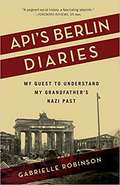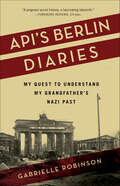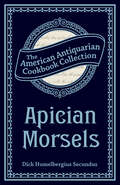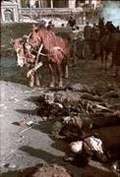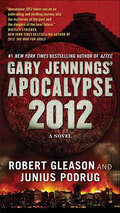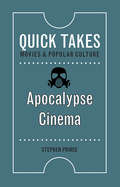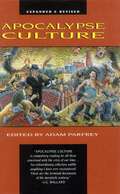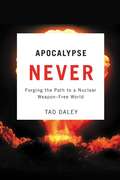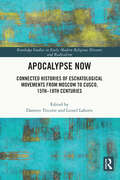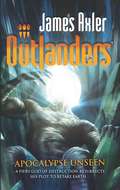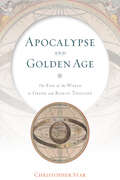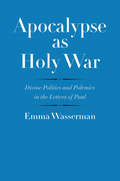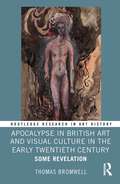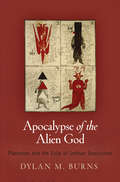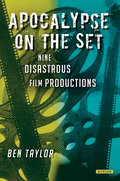- Table View
- List View
Aphrodite and the Rabbis: How the Jews Adapted Roman Culture to Create Judaism as We Know It
by Burton L. VisotzkyHard to believe but true:- The Passover Seder is a Greco-Roman symposium banquet- The Talmud rabbis presented themselves as Stoic philosophers- Synagogue buildings were Roman basilicas- Hellenistic rhetoric professors educated sons of well-to-do Jews- Zeus-Helios is depicted in synagogue mosaics across ancient Israel- The Jewish courts were named after the Roman political institution, the Sanhedrin- In Israel there were synagogues where the prayers were recited in Greek.Historians have long debated the (re)birth of Judaism in the wake of the destruction of Jerusalem and the Temple cult by the Romans in 70 CE. What replaced that sacrificial cult was at once something new–indebted to the very culture of the Roman overlords–even as it also sought to preserve what little it could of the old Israelite religion. The Greco-Roman culture in which rabbinic Judaism grew in the first five centuries of the Common Era nurtured the development of Judaism as we still know and celebrate it today. Arguing that its transformation from a Jerusalem-centered cult to a world religion was made possible by the Roman Empire, Rabbi Burton Visotzky presents Judaism as a distinctly Roman religion. Full of fascinating detail from the daily life and culture of Jewish communities across the Hellenistic world, Aphrodite and the Rabbis will appeal to anyone interested in the development of Judaism, religion, history, art and architecture.
Aphrodite's Daughters: Three Modernist Poets of the Harlem Renaissance
by Maureen HoneyThe Harlem Renaissance was a watershed moment for racial uplift, poetic innovation, sexual liberation, and female empowerment. Aphrodite's Daughters introduces us to three amazing women who were at the forefront of all these developments, poetic iconoclasts who pioneered new and candidly erotic forms of female self-expression. Maureen Honey paints a vivid portrait of three African American women--Angelina Weld Grimké, Gwendolyn B. Bennett, and Mae V. Cowdery--who came from very different backgrounds but converged in late 1920s Harlem to leave a major mark on the literary landscape. She examines the varied ways these poets articulated female sexual desire, ranging from Grimké's invocation of a Sapphic goddess figure to Cowdery's frank depiction of bisexual erotics to Bennett's risky exploration of the borders between sexual pleasure and pain. Yet Honey also considers how they were united in their commitment to the female body as a primary source of meaning, strength, and transcendence. The product of extensive archival research, Aphrodite's Daughters draws from Grimké, Bennett, and Cowdery's published and unpublished poetry, along with rare periodicals and biographical materials, to immerse us in the lives of these remarkable women and the world in which they lived. It thus not only shows us how their artistic contributions and cultural interventions were vital to their own era, but also demonstrates how the poetic heart of their work keeps on beating.
Api's Berlin Diaries: My Quest to Understand My Grandfather's Nazi Past
by Gabrielle RobinsonMoving and provocative, Api’s Berlin Diaries offers a personal perspective on the fall of Berlin 1945 and the far-reaching aftershocks of the Third Reich. <P><P> After her mother’s death, Robinson found her grandfather’s diaries and discovered that he had been a member of the Nazi party. Her memoir juxtaposes her grandfather’s harrowing account serving as doctor in the ruins of Berlin with her memories of his loving protection after the war, and raises disturbing questions about the political responsibility we all carry as individuals.
Api's Berlin Diaries: My Quest to Understand My Grandfather's Nazi Past
by Gabrielle RobinsonA haunting personal story of Berlin at the end of the Third Reich—and an unflinching investigation into a family’s Nazi pastWhen Gabrielle Robinson found her grandfather’s Berlin diaries, hidden behind books in her mother’s Vienna apartment, she made a shocking discovery—her beloved Api had been a Nazi.The entries record his daily struggle to survive in a Berlin that was 90% destroyed. Near collapse himself Api, a doctor, tried to help the wounded and dying in nightmarish medical cellars without cots, water or light. The dead were stacked in the rubble outside.Searching to understand why her grandfather had joined the Nazi party, Robinson retraces his steps in the Berlin of the 21st century. She reflects on German guilt, political responsibility, and facing the past. But she also remembers Api, who had given her a loving home in those cold and hungry post-war years.“This a must read for anyone interested in the German experience during WWII”—Ariana Neumann, author of When Time StoppedScroll up and click “buy now” to read Api’s Berlin Diaries today
Apician Morsels: Or, Tales of the Table, Kitchen, and Larder
by Dick SecundusPublished in 1829 in New York, Apician Morsels, or Tales of the Table, Kitchen, and Larder is an entertaining culinary miscellany that combines cooking history, lore, anecdotes, and witticism, all with a humorous flair. While Dick Humelbergius Secundus is the listed author (a tongue-in-cheek allusion to a 16th century annotator), the tome is believed to have been written by English novelist William Beckford. Continuing the jesting nature of the book, the title page proclaims to &“[a]lways breakfast as if you did not intend to dine; and dine as if you had not broken your fast.&” Furthermore, Apician Morsels explores oddities and fascinating lore such as the history of the toothpick, Roman customs on eating and drinking, and quirky antiquarian books on cooking, and warns about avoiding the most frightful of dining situations: eating alone at one&’s own home. This edition of Apician Morsels, or Tales of the Table, Kitchen and Larder was reproduced by permission from the volume in the collection of the American Antiquarian Society, Worcester, Massachusetts. Founded in 1812 by Isaiah Thomas, a Revolutionary War patriot and successful printer and publisher, the Society is a research library documenting the life of Americans from the colonial era through 1876. The Society collects, preserves, and makes available as complete a record as possible of the printed materials from the early American experience. The cookbook collection includes approximately 1,100 volumes.
Apician Morsels: Or, Tales of the Table, Kitchen, and Larder
by Dick SecundusPublished in 1829 in New York, Apician Morsels, or Tales of the Table, Kitchen, and Larder is an entertaining culinary miscellany that combines cooking history, lore, anecdotes, and witticism, all with a humorous flair. While Dick Humelbergius Secundus is the listed author (a tongue-in-cheek allusion to a 16th century annotator), the tome is believed to have been written by English novelist William Beckford. Continuing the jesting nature of the book, the title page proclaims to &“[a]lways breakfast as if you did not intend to dine; and dine as if you had not broken your fast.&” Furthermore, Apician Morsels explores oddities and fascinating lore such as the history of the toothpick, Roman customs on eating and drinking, and quirky antiquarian books on cooking, and warns about avoiding the most frightful of dining situations: eating alone at one&’s own home. This edition of Apician Morsels, or Tales of the Table, Kitchen and Larder was reproduced by permission from the volume in the collection of the American Antiquarian Society, Worcester, Massachusetts. Founded in 1812 by Isaiah Thomas, a Revolutionary War patriot and successful printer and publisher, the Society is a research library documenting the life of Americans from the colonial era through 1876. The Society collects, preserves, and makes available as complete a record as possible of the printed materials from the early American experience. The cookbook collection includes approximately 1,100 volumes.
Apocalypse 1945: the Destruction of Dresden
by David IrvingDescribes the bombing of Dresden by the allies in 1945. The bombing started a firestorm which destroyed the city.
Apocalypse 2012: A Novel (Aztec)
by Gary Jennings Junius Podrug Robert GleasonIn ancient Mexico, the "End-Time Codex"--prophesizing the world's end in 2012--is entombed. A young Aztec-Mayan slave tells us its story. Gifted in math and astronomy, Coyotl rises to king's counselor in Tula, a golden city of milk and honey ruled by the brilliant god-king, Quetzalcoatl, the Feathered Serpent of lore. Gathering artists, scientists and craftsmen, this legendary ruler builds a city that will awe humanity for one thousand years. But he also faces war, catastrophic drought, betrayal and the rise of an evil death-cult religion. Instituting the infamous "Blood Covenant," its priests drag thousands of people a year atop temple-pyramids and rip their hearts beating from their chests. To stop them Quetzalcoatl must defy the flames of bloody civil war.A thousand years later scientists discover the End-Time Codex. While struggling to decipher it, they realize their own age mirrors Tula's. Can they crack the 2012 code and save their world from Tula's deadly fate?At the Publisher's request, this title is being sold without Digital Rights Management Software (DRM) applied.
Apocalypse Cinema (Quick Takes: Movies and Popular Culture)
by Stephen PrinceVivid images of the apocalypse proliferate throughout contemporary cinema, which pictures the death of civilization in wildly different ways. Some films imagine a future where humanity is wiped out entirely, while others envision humans as an endangered species, enslaved by alien invaders or hunted by zombie hordes. This book provides a lively overview of apocalypse cinema, including alien invasions, nuclear annihilation, asteroid collisions, climate change, and terrifying plagues. Covering pivotal films from the silent era to the present day, including Metropolis, Invasion of the Body Snatchers, Dr. Strangelove, Contagion, and Avengers: Endgame, Stephen Prince explores how these dark visions are rooted in religious and prophetic traditions, and he considers how our love for apocalypse cinema is tied to fundamental existential questions and anxieties that never go out of fashion.
Apocalypse Culture
by Adam Parfrey"Parfrey has edited a new book of Revelation, a collection which is almost as awesome and terrifying as the original biblical text."--Edwin Pouncey, NME"Apocalypse Culture is compulsory reading for all those concerned with the crisis of our times. An extraordinary collection unlike anything I have ever encountered. These are the terminal documents of the twentieth century."--J.G. Ballard
Apocalypse Delayed
by M. James PentonSince 1876, Jehovah's Witnesses have believed that they are living in the last days of the present world. Charles T. Russell, their founder, advised his followers that members of Christ's church would be raptured in 1878, and by 1914 Christ would destroy the nations and establish his kingdom on earth. The first prophecy was not fulfilled, but the outbreak of the First World War lent some credibility to the second. Ever since that time, Jehovah's Witnesses have been predicting that the world would end "shortly." Their numbers have grown to many millions in over two hundred countries. They distribute a billion pieces of literature annually, and continue to anticipate the end of the world.For almost thirty years, M. James Penton's Apocalypse Delayed has been the definitive scholarly study of this religious movement. As a former member of the sect, Penton offers a comprehensive overview of the Jehovah's Witnesses. His book is divided into three parts, each presenting the Witnesses' story in a different context: historical, doctrinal, and sociological. Some of the issues he discusses are known to the general public, such as the sect's opposition to military service and blood transfusions. Others involve internal controversies, including political control of the organization and the handling of dissent within the ranks.Thoroughly revised, the third edition of Penton's classic text includes substantial new information on the sources of Russell's theology and on the church's early leaders, as well as coverage of important developments within the sect since the second edition was published fifteen years ago.
Apocalypse Never: Forging the Path to a Nuclear Weapon-Free World
by Tad DaleyApocalypse Never maintains that the abolition of nuclear weapons is both essential and achievable, and reveals in fine detail what we need to do--both governments and movements--to make it a reality. Tad Daley insists that while global climate change poses the single greatest long-term peril to the human race, the nuclear challenge in its many incarnations--nuclear terror, nuclear accident, a nuclear crisis spinning out of control--poses the single most immediate peril. Daley has written a book for the general reader about this most crucial of contemporary challenges.
Apocalypse Now: Connected Histories of Eschatological Movements from Moscow to Cusco, 15th-18th Centuries (Routledge Studies in Early Modern Religious Dissents and Radicalism)
by Lionel Laborie Damien TricoireEschatology played a central role in both politics and society throughout the early modern period. It inspired people to strive for social and political change, including sometimes by violent means, and prompted in return strong reactions against their religious activism. From the fifteenth to the eighteenth century, numerous apocalyptical and messianic movements came to the fore across Eurasia and North Africa, raising questions about possible interconnections. Why were eschatological movements so pervasive in early modern times? This volume provides some answers to this question by exploring the interconnected histories of confessions and religions from Moscow to Cusco. It offers a broad picture of Christian and, to a lesser extent, Jewish and Islamic eschatological movements from the fifteenth to the eighteenth century, thereby bridging important and long-standing gaps in the historiography. Apocalypse Now will appeal to both researchers and students of the history of early modern religion and politics in the Christian, Jewish and Islamic worlds. By exploring connections between numerous eschatological movements, it gives a fresh insight into one of the most promising fields of European and global history.
Apocalypse Then: American Intellectuals and the Vietnam War, 1954-1975
by Robert R. TomesPrior to the Vietnam war, American intellectual life rested comfortably on shared assumptions and often common ideals. Intellectuals largely supported the social and economic reforms of the 1930s, the war against Hitler's Germany, and U.S. conduct during the Cold War. By the early 1960s, a liberal intellectual consensus existed. The war in Southeast Asia shattered this fragile coalition, which promptly dissolved into numerous camps, each of which questioned American institutions, values, and ideals. Robert R. Tomes sheds new light on the demise of Cold War liberalism and the development of the New Left, and the steady growth of a conservatism that used Vietnam, and anti-war sentiment, as a rallying point. Importantly, Tomes provides new evidence that neoconservatism retreated from internationalism due largely to Vietnam, only to regroup later with substantially diminished goals and expectations. Covering vast archival terrain, Apocalypse Then stands as the definitive account of the impact of the Vietnam war on American intellectual life.
Apocalypse Unseen
by James AxlerFar in the future, mankind endures the relentless onslaught of alien oppressors, an ancient battle whose tide has begun to turn through the efforts of the Cerberus rebels. This remarkable band of warriors fights an elusive enemy, traveling through dangerous portals of time and space, where reality and un-reality collide in stunning, deadly purpose…
Apocalypse and Golden Age: The End of the World in Greek and Roman Thought
by Christopher StarHow did the ancient Greeks and Romans envision the end of the world?What is the long-term future of the human race? Will the world always remain as it is or will it undergo a catastrophic change? What role do the gods, human morality, and the forces of nature play in bringing about the end of the world? In Apocalypse and Golden Age, Christopher Star reveals the answers that Greek and Roman authors gave to these questions. The first large-scale investigation of the various scenarios for the end of the world in classical texts, this book demonstrates that key thinkers often viewed their world as shaped by catastrophe. Star focuses on how this theme was explored over the centuries in the works of poets, such as Hesiod, Vergil, Ovid, and Lucan, and by philosophers, including the Presocratics, Plato, Epicurus, Lucretius, Cicero, and Seneca. With possibilities ranging from periodic terrestrial catastrophes to the total dissolution of the world, these scenarios address the ultimate limits that define human life and institutions, and place humanity in the long perspective of cosmic and natural history. These texts also explore various options for the rebirth of society after world catastrophe, such as a return of the Golden Age or the redevelopment of culture and political institutions. Greek and Roman visions of the end, Star argues, are not calls to renounce this world and prepare for a future kingdom. Rather, they are set within larger investigations that examine and seek to improve personal and political life in the present. Contextualizing classical thought about the apocalypse with biblical studies, Star shows that the seeds of our contemporary anxieties about globalization, politics, and technology were sown during the Roman period. Even the prevalent link between an earthly leader and the beginning of the end times can be traced back to Greek and Roman rulers, the emperor Nero in particular. Apocalypse and Golden Age enriches our understanding of apocalyptic thought.
Apocalypse and Reform from Late Antiquity to the Middle Ages
by James T. Palmer Matthew GabrieleApocalypse and Reform from Late Antiquity to the Middle Ages provides a range of perspectives on what reformist apocalypticism meant for the formation of Medieval Europe, from the Fall of Rome to the twelfth century. It explores and challenges accepted narratives about both the development of apocalyptic thought and the way it intersected with cultures of reform to influence major transformations in the medieval world. Bringing together a wealth of knowledge from academics in Britain, Europe and the USA this book offers the latest scholarship in apocalypse studies. It consolidates a paradigm shift, away from seeing apocalypse as a radical force for a suppressed minority, and towards a fuller understanding of apocalypse as a mainstream cultural force in history. Together, the chapters and case studies capture and contextualise the variety of ideas present across Europe in the Middle Ages and set out points for further comparative study of apocalypse across time and space. Offering new perspectives on what ideas of ‘reform’ and ‘apocalypse’ meant in Medieval Europe, Apocalypse and Reform from Late Antiquity to the Middle Ages provides students with the ideal introduction to the study of apocalypse during this period.
Apocalypse and the Millennium in the American Civil War Era: Radical Movements in the Southwest, 1895--1943 (Conflicting Worlds: New Dimensions of the American Civil War)
by Mark A. Noll Jennifer Graber Ryan Cordell Edward J. Blum Robert Nelson Nina Reid-Maroney Jason Phillips Zachary W. Dresser Charles Irons Joseph Moore Matthew Harper Ben Wright Scott NesbitIn the Civil War era, Americans nearly unanimously accepted that humans battled in a cosmic contest between good and evil and that God was directing history toward its end. The concept of God's Providence and of millennialism -- Christian anticipations of the end of the world -- dominated religious thought in the nineteenth century. During the tumultuous years immediately prior to, during, and after the war, these ideas took on a greater importance as Americans struggled with the unprecedented destruction and promise of the period. Scholars of religion, literary critics, and especially historians have acknowledged the presence of apocalyptic thought in the era, but until now, few studies have taken the topic as their central focus or examined it from the antebellum period through Reconstruction. By doing so, the essays in Apocalypse and the Millennium in the American Civil War Era highlight the diverse ways in which beliefs about the end times influenced nineteenth-century American lives, including reform culture, the search for meaning amid the trials of war, and the social transformation wrought by emancipation. Millennial zeal infused the labor of reformers and explained their successes and failures as progress toward an imminent Kingdom of God. Men and women in the North and South looked to Providence to explain the causes and consequences of both victory and defeat, and Americans, black and white, experienced the shock waves of emancipation as either a long-prophesied jubilee or a vengeful punishment. Religion fostered division as well as union, the essays suggest, but while the nation tore itself apart and tentatively stitched itself back together, Americans continued looking to divine intervention to make meaning of the national apocalypse. Contributors:Edward J. BlumRyan CordellZachary W. DresserJennifer GraberMatthew HarperCharles F. IronsJoseph MooreRobert K. NelsonScott Nesbit Jason PhillipsNina Reid-MaroneyBen Wright
Apocalypse as Holy War: Divine Politics and Polemics in the Letters of Paul (The Anchor Yale Bible Reference Library)
by Emma WassermanPrevailing theories of apocalypticism assert that in a world that rebels against God, a cataclysmic battle between good and evil is needed to reassert God’s dominion. Emma Wasserman, a rising scholar of early Christian history, challenges this interpretation and reframes Paul’s apocalyptic texts as myths about politics in the world of divinity. Wasserman argues that the most dominant historical-critical theories about Christian apocalypticism are ahistorical and tend to work with apologetic formulations of Christ’s victory and the uniqueness of Christianity. Assessing Paul’s claims about immanent war, divine enemies, and the transformation that will accompany Christ’s return, Wasserman sees him as envisioning a single, righteously ruled cosmic kingdom, the true nature of which will soon be revealed to all. A major scholarly contribution that ranges across Mediterranean and West Asian religious thought, this volume has broad implications for understanding Paul’s myth of heroic submission as well as his most distinctive ethical teachings.
Apocalypse in British Art and Visual Culture in the Early Twentieth Century: Some Revelation (Routledge Research in Art History)
by Thomas BromwellThis book is the first substantial study of the presence and relationship with the concepts of apocalypse, eschatology, and millennium in modern British art from 1914 to 1945, addressing how and why practitioners in both religious and secular spheres turned to the subjects.The volume examines British art and visual culture’s relationship with the then-contemporary anxieties and hopes regarding the orientation of society and culture, arguing that there is an acute relationship to the particular forms of cultural discourse of eschatology, apocalypse, and millennium. Chapters identify the continued relevance of religion and religious themes in British art during the period, and demonstrate that eschatology, apocalypse, and millennium were thriving and surprisingly mainstream concepts in the period that remained vital in early to mid-twentieth-century society and culture.This book is a research monograph aimed at an audience of scholars and graduate students already familiar with the core focus of modern British art and cultural histories, especially those working on the late nineteenth and early twentieth centuries, or the concepts of apocalypse, eschatology, and millennium in Theology, Sociology, or other disciplinary settings. It will also be of interest to scholars and students working on war and visual culture, or histories of imperialism.It will benefit scholars of early twentieth-century British art, demonstrating the intersection of art and religion in the modern era, and critically qualifies the standard secular canon and narrative of modern British art, and the general neglect of religion in existing art-historical literature.
Apocalypse of the Alien God: Platonism and the Exile of Sethian Gnosticism (Divinations: Rereading Late Ancient Religion)
by Dylan M. BurnsIn the second century, Platonist and Judeo-Christian thought were sufficiently friendly that a Greek philosopher could declare, "What is Plato but Moses speaking Greek?" Four hundred years later, a Christian emperor had ended the public teaching of subversive Platonic thought. When and how did this philosophical rupture occur? Dylan M. Burns argues that the fundamental break occurred in Rome, ca. 263, in the circle of the great mystic Plotinus, author of the Enneads. Groups of controversial Christian metaphysicians called Gnostics ("knowers") frequented his seminars, disputed his views, and then disappeared from the history of philosophy—until the 1945 discovery, at Nag Hammadi, Egypt, of codices containing Gnostic literature, including versions of the books circulated by Plotinus's Christian opponents. Blending state-of-the-art Greek metaphysics and ecstatic Jewish mysticism, these texts describe techniques for entering celestial realms, participating in the angelic liturgy, confronting the transcendent God, and even becoming a divine being oneself. They also describe the revelation of an alien God to his elect, a race of "foreigners" under the protection of the patriarch Seth, whose interventions will ultimately culminate in the end of the world.Apocalypse of the Alien God proposes a radical interpretation of these long-lost apocalypses, placing them firmly in the context of Judeo-Christian authorship rather than ascribing them to a pagan offshoot of Gnosticism. According to Burns, this Sethian literature emerged along the fault lines between Judaism and Christianity, drew on traditions known to scholars from the Dead Sea Scrolls and Enochic texts, and ultimately catalyzed the rivalry of Platonism with Christianity. Plunging the reader into the culture wars and classrooms of the high Empire, Apocalypse of the Alien God offers the most concrete social and historical description available of any group of Gnostic Christians as it explores the intersections of ancient Judaism, Christianity, Hellenism, myth, and philosophy.
Apocalypse on the Set
by Ben TaylorWith sky-high budgets and competing egos, almost any film production has the potential for disaster. But some become full-fledged nightmares. Take Pulgasari - a North Korean Godzilla clone dreamed up by Kim Jong II and created by a kidnapped South Korean director, with a budget of millions and a staff of seven hundred fed on truckloads of pheasants, wild geese and deer . . . The stories behind the other eight films, from The Adventures of Baron Munchausen and The Twilight Zone: The Movie to Waterworld and The Crow, are just as astounding and as gripping. This is a book film fans will devour. These bizarre, often hilarious cinematic endeavours confirm that truth is stranger than fiction, reality more volatile than narratives, and fate more improbable than plots.
Apocalypse on the Set: Nine Disastrous Film Productions
by Ben TaylorThe book starts with Pulgasari--a North Korean Godzilla clone dreamed up by Kim Jong-Il and created by a kidnapped Korean director, with a budget of millions and a staff of seven hundred fed on truckloads of pheasants, wild geese, and deer. The stories behind the other eight films, from The Adventures of Baron Munchausen and The Twilight Zone: The Movie to Apocalypse Now and The Crow, are just as astounding and gripping--this is a book film fans will devour. These bizarre, often hilarious cinematic endeavors confirm that truth is stranger than fiction, reality more volatile than narratives, and fate more improbable than plots.
Apocalypse on the Set: Nine Disastrous Film Productions
by Ben TaylorThe book starts with Pulgasari--a North Korean Godzilla clone dreamed up by Kim Jong-Il and created by a kidnapped Korean director, with a budget of millions and a staff of seven hundred fed on truckloads of pheasants, wild geese, and deer. The stories behind the other eight films, from The Adventures of Baron Munchausen and The Twilight Zone: The Movie to Apocalypse Now and The Crow, are just as astounding and gripping--this is a book film fans will devour. These bizarre, often hilarious cinematic endeavors confirm that truth is stranger than fiction, reality more volatile than narratives, and fate more improbable than plots.
Apocalypse without God: Apocalyptic Thought, Ideal Politics, and the Limits of Utopian Hope
by Ben JonesApocalypse, it seems, is everywhere. Preachers with vast followings proclaim the world's end. Apocalyptic fears grip even the nonreligious amid climate change, pandemics, and threats of nuclear war. As these ideas pervade popular discourse, grasping their logic remains elusive. Ben Jones argues that we can gain insight into apocalyptic thought through secular thinkers. He starts with a puzzle: Why would secular thinkers draw on Christian apocalyptic beliefs – often dismissed as bizarre – to interpret politics? The apocalyptic tradition proves appealing in part because it theorizes a relation between crisis and utopia. Apocalyptic thought points to crisis as the vehicle to bring the previously impossible within reach, offering resources for navigating challenges in ideal theory, which involves imagining the best, most just society. By examining apocalyptic thought's appeal and risks, this study arrives at new insights on the limits of utopian hope. This title is available as open access on Cambridge Core.


